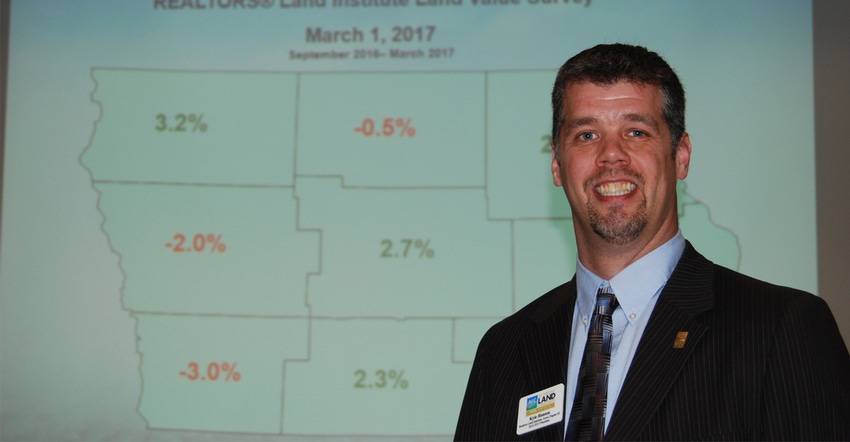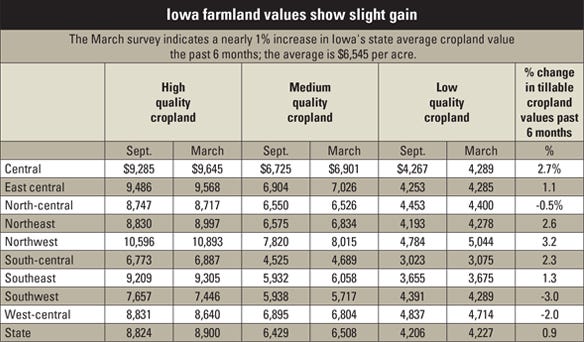
Demand for Iowa farmland remains strong, despite another year of reduced farm income from low corn and soybean prices. While land demand is strong, there isn’t much land being offered for sale.
That’s how farm real estate professionals attending the March 22 meeting of the Iowa Realtors Land Institute at Ames summed up the current supply-demand situation for cropland. Competition for farmland is as intense as it’s been in the past 20 years, they say, due to a “very limited” amount of land available for sale. Also, more outside investors are getting back into the market, bidding against farmers who want to buy land.
“It’s definitely a tighter market now,” says Kyle Hansen, a real estate agent with Hertz Real Estate Services. “There are a lot of strong buyers interested, and there are very few opportunities to buy. It’s similar to the 1980s when farmers and investors with cash on hand waited to see where the bottom of the land market was, before they decided to make their purchase.”
Statewide values up less than 1%
At this year’s March meeting, the Iowa Realtors’ organization released its March 1 survey of its members. The statewide survey shows Iowa farmland values climbed nearly 1% during the past six months, ending a three-year decline that saw values plummet nearly 30% from their peak in 2013. The average value of tillable cropland acres in Iowa as of March increased by 0.9% since last September: a key reversal compared to the 3.7% decrease during the preceding six months.
The climb of 0.9% in Iowa’s average land value from September 2016 to March 2017 offers a glimmer of hope that the downturn in the ag economy may be turning around, says Hansen, who coordinates the survey for the Realtors Land Institute. The survey is conducted each March and September. Iowa’s average cropland value is now $6,545 per acre, according to the March survey.
However, as the table below shows, the trend deviated across Iowa’s nine crop reporting districts ranging from a 3.2% increase in average cropland values in northwest Iowa to a 3% decrease in the southwest district. Land values increased in six of Iowa’s nine crop reporting districts.

Crop prices, yield had impact
Iowa generally had a big year for corn and bean yields in 2016, but some areas of the state had better yields than others. “I think this difference in land values for the crop reporting districts from north to south in Iowa has a lot to do with what crop prices have done, and also what yields have done,” says Hansen.
Putting the average value of Iowa farmland at $6,545 per acre, the survey aligns with trends indicated by other land value surveys. Iowa State University’s land value survey in November showed a 5.9% decline in farmland values for the year; a Chicago Federal Reserve report in January showed a smaller 2% decline.
Location and quality of land are the two most important factors in determining the value of a particular piece of ground, says Hansen. He told how a recent 80-acre tract in central Iowa sold for more than $1,000 an acre above expectations, thanks to competitive bidding by two adjoining landowners and a third farmer in the area.
“We are seeing sales of land priced all over the board,” says Hansen. “This is a volatile land market right now. It’s definitely a tighter market. And there are some strong buyers.”
Farmers are still main buyers
Farmers make up about 72% of cropland buyers, according to the survey. The main sellers of land are still estates and heirs, as they have been in the past. About one-fourth of farmland sales are involved with a Section 1031 tax deferred exchange.
Auctions are still the primary way farmland is sold. Although there have been some “no sales” if the bid price doesn’t reach the seller’s expectations. Those situations are often resolved by negotiations afterword, and a sale is made.
“This improvement of a little less than 1% in Iowa farmland value over the past six months could be a sign that the land market is stabilizing,” says Hansen. “The market is taking a breath and trying to figure out which direction it will go in the future.”
That direction will depend a lot on the price of corn and soybeans this coming fall, along with yields. Iowa farmland peaked in value in 2013, but has since fallen along with crop prices and U.S. farm income. Nationwide, USDA projects farm earnings to be $62.3 billion this year, about half of what it was in 2013, USDA data shows.
The average value of Iowa farmland has dropped about 25% since March 2013, based on the Realtor group’s surveys. Iowa farm income was about $5.6 billion in 2015 (the most recent data available), down about 42% from $9.6 billion in 2011.
Have land values hit bottom yet?
“We don’t know if we’ve hit bottom on the land market yet, and if it will soon start moving higher,” says Hansen. “Hopefully, that’s what’s happening.” Industry data shows Iowa had about half of the farmland sales in 2016 as it did in 2013. ISU’s survey results last November showed average farmland values had fallen 5.9% to $7,183 per acre over the past year. It was the third annual decline in a row for land values, and the first time this has happened since the 1980s farm financial crisis.
The Iowa Realtors Land Institute in its March survey based its values on the surveys returned by about 135 ag real estate brokers, appraisers and other land professionals statewide. Looking ahead, Hansen expects farmland values to keep tracking crop prices. Crop insurance has helped put a floor under land prices, but current USDA commodity programs like Agricultural Risk Coverage don’t seem to have much influence on the market, he says.
About the Author(s)
You May Also Like




